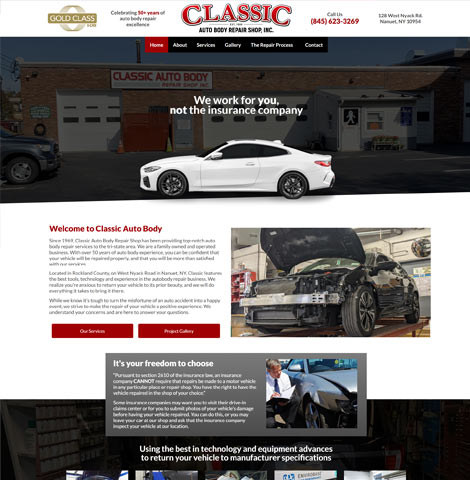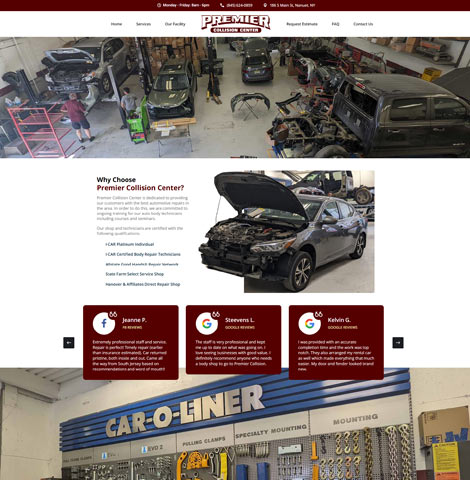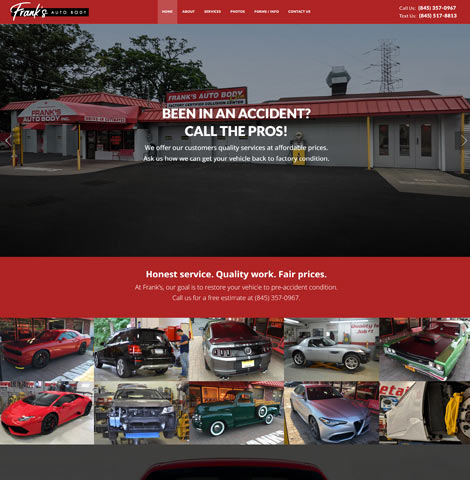Your website is your 24/7 salesperson. To turn visitors into paying customers, it needs certain key features. Here are the top website elements that boost conversion for auto body shops.
Clear Calls to Action (CTAs)
Buttons like “Get a Free Estimate,” “Book Appointment,” or “Contact Us Today” guide visitors to take the next step. These CTAs should be placed strategically throughout the website on the homepage, service pages, and even blog posts.
The wording should be action-oriented and benefit-driven. For example, instead of just saying “Contact,” using “Contact Us for a Fast, Free Repair Quote” makes the value clear. CTAs work best when they’re easy to find, visually stand out, and aligned with what the user is already thinking. For example, if someone is reading about dent repair, having a button nearby that says “Request a Dent Repair Estimate” can help convert them at the right moment.
Online Estimate Requests
Providing a quick, easy form to submit vehicle damage details lets potential customers get an instant quote. These forms not only reduce the need for a phone call but also allow you to gather important customer information ahead of time. For higher conversion rates, the form should ask only the most essential questions like name, contact info, photos of the damage, and vehicle make and model.
You can also reassure users by letting them know how fast they’ll receive a response something like “We’ll respond within 1 business hour” helps set expectations. Making the estimate form accessible on both desktop and mobile ensures you capture leads regardless of how users find your site.
Appointment Scheduling Integration
A calendar or booking system reduces friction by letting visitors pick convenient times without calling. Many users browse during off-hours and prefer the convenience of self-scheduling. Integrating tools like Calendly, Bookly, or a custom scheduler into your website allows users to instantly choose an available time slot.
You can also segment by service type, so someone scheduling a bumper repair can choose the time needed specifically for that service. Auto-confirmation emails and SMS reminders help reduce no-shows and make your business look more professional. Giving users the ability to reschedule or cancel online adds to the seamless experience and shows that your business values their time.
Testimonials and Reviews
Displaying positive feedback builds confidence that your shop delivers quality service. Visitors tend to trust the words of past customers more than your own sales language. Featuring reviews from platforms like Google, Yelp, or Facebook, alongside names and photos (if possible), gives credibility. Even short quotes like “They fixed my car like new in just two days!” can make a strong impact.
Highlight a mix of feedback across different services to show your range of expertise. You can even create a “Customer Stories” section where a few clients share more detailed experiences, helping future customers imagine what it’s like to work with you. Authenticity is key—don’t over-polish or hide all the negative reviews. Addressing issues professionally also builds trust.
Before and After Galleries
Show real repair results with photos this visual proof is a powerful conversion tool. A high-quality photo gallery with clearly labeled images demonstrates your skill and attention to detail. Visitors often want to see repairs similar to their own, so consider categorizing images by service type like “paint jobs,” “dent removal,” or “frame repair.”
You can also include brief descriptions of what damage was fixed and how long the job took. Having a clickable photo that opens a larger view with more context makes the gallery interactive and engaging. People trust what they see, and a well-organized photo section shows that your business delivers visible, measurable results.
Trust Badges and Certifications
Highlight awards, certifications, and guarantees that reassure visitors of your professionalism. Trust signals such as I-CAR Gold Class certification, ASE credentials, Better Business Bureau ratings, or insurance partnerships all communicate that your shop is reputable and qualified. These badges are especially important for new visitors who haven’t heard of your shop before.
Consider placing them near CTAs, in your site’s footer, or on a dedicated “About” page. You can also add short explanations like “Certified by I-CAR for structural and cosmetic repairs,” so users know what each badge actually means. Warranties and satisfaction guarantees can be displayed as icons or quick statements to reinforce quality assurance.
Fast Loading and Mobile-Friendly Design
Visitors expect quick access on any device. Slow or clunky sites lose potential business. In fact, most users will leave a website if it takes longer than 3 seconds to load. This is especially true on mobile, where attention spans are shorter and performance expectations are higher. Use compressed images, a good hosting provider, and a clean design to ensure speed.
Mobile-friendly design doesn’t just mean the site looks smaller it should be fully functional on smaller screens with easy navigation, tappable buttons, and readable text. Google also favors mobile-friendly websites in search rankings, giving your shop a competitive edge. A seamless browsing experience builds trust and keeps visitors engaged longer, increasing the likelihood of conversion.
Conclusion
Your auto body shop’s website should do more than just exist it should actively convert visitors into paying customers. By including clear CTAs, online estimates, scheduling tools, and trust-building elements like reviews and certifications, you give users every reason to choose your shop. Combined with fast loading times and mobile responsiveness, these features turn your website into one of your most powerful business tools. In today’s competitive market, having the right features isn’t a luxury it’s what separates thriving shops from the rest.





